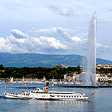CHÂTEAU DE COPPET LAKE GENEVA
Madame de Staël’s Swiss Salon and the Emperor
 The Emperor
Napoleon in exile for the last time on the Isle of St Helena after
the end of
his glorious reign turned to inglorious solitude, between
complaining about his treatment under his British custodians spent his
time writing memoirs. In them he expressed one great regret, if only
he had not spurned one particular woman. Madame Germaine de Staël
was born in Paris, Anne Louise Germaine Necker, the daughter of Jacques
Necker, then Finance Minister to King Louis XVI. Jacques Necker along
with the Rothchilds, through his connections to the French monarchy had
been one of the progenitors of the Swiss banking system. One of his elegant
watches can be found in the collection of Patek Phillipe in Geneva (see Patek
Philippe Museum Geneva). Neckar bought a Chateau in the
little village of Coppet on the shores of Lake Geneva in 1784, with the
intention
of
retiring there, but the house became a family refuge during the bloody
heights of the French Revolution.
The Emperor
Napoleon in exile for the last time on the Isle of St Helena after
the end of
his glorious reign turned to inglorious solitude, between
complaining about his treatment under his British custodians spent his
time writing memoirs. In them he expressed one great regret, if only
he had not spurned one particular woman. Madame Germaine de Staël
was born in Paris, Anne Louise Germaine Necker, the daughter of Jacques
Necker, then Finance Minister to King Louis XVI. Jacques Necker along
with the Rothchilds, through his connections to the French monarchy had
been one of the progenitors of the Swiss banking system. One of his elegant
watches can be found in the collection of Patek Phillipe in Geneva (see Patek
Philippe Museum Geneva). Neckar bought a Chateau in the
little village of Coppet on the shores of Lake Geneva in 1784, with the
intention
of
retiring there, but the house became a family refuge during the bloody
heights of the French Revolution.
 Madame
de Stael attained her more familiar title from an arranged marriage
to
the Swedish Ambassador
to France. A woman of plain looks, but sharp
mind and a bit of a coquette, her marriage was loveless and she had more
than a few liaisons, but Emperor Napoleon would find hell hath no fury
as a woman scorned - who knows how to use a pen. Madame de Stael could
write and her literary salons in Paris were legendary. At a party given
by minister Talleyrand celebrating Napoleon's his conquering of Italy
(see Colorno
Palace Parma), the budding author asked the general
who he thought was the greatest
woman of the time and he responded – “she who has bourne
the most children.” He later said of the encounter, “She
combined all her resources to make an impression upon the General of
the Army of Italy. Unfortunately, the general's only answer was an indifference
which women never forgive.”
Madame
de Stael attained her more familiar title from an arranged marriage
to
the Swedish Ambassador
to France. A woman of plain looks, but sharp
mind and a bit of a coquette, her marriage was loveless and she had more
than a few liaisons, but Emperor Napoleon would find hell hath no fury
as a woman scorned - who knows how to use a pen. Madame de Stael could
write and her literary salons in Paris were legendary. At a party given
by minister Talleyrand celebrating Napoleon's his conquering of Italy
(see Colorno
Palace Parma), the budding author asked the general
who he thought was the greatest
woman of the time and he responded – “she who has bourne
the most children.” He later said of the encounter, “She
combined all her resources to make an impression upon the General of
the Army of Italy. Unfortunately, the general's only answer was an indifference
which women never forgive.”
She did not. She was a constant critic of Napoleon Bonaparte. Yet, even he paid her the rare compliment of recognizing the power of her pen in his memoir. “It cannot be denied that Madame de Stael is a distinguished woman, endowed with great talents, and possessing a considerable share of wit. She was ardent in her passions, vehement and extravagant in her expressions...an adversary to be feared. She and I have waged a little war against each other.” So vexed by her criticisms, the Emperor had her banished from Paris. Madame Germaine de Stael moved her salons to the Swiss chateau in Coppet, where she continued to attract authors and literati. Lord Byron was a regular guest during his stay in Geneva (see Villa Diodati and the Gothic Summer).
 An
early 13th Century chateau of the Savoy period was mostly destroyed
by a
fire, while the current Chateau Coppet is of the 18th Century symmetrical
manor house form. One medieval tower remains at the corner
of a cobble-stone courtyard. Informal gardens surround the house which
still
remains in
the hands of the descendents of Madame de Stael. Guided tours of the
public areas of house are available. The chateau retains the feeling
of a lived in elegant period home, with a collection of portraits of
past residents. The Chateau de Coppet is open for visitors from Easter
until October 31, every day from 2pm to 6pm.
An
early 13th Century chateau of the Savoy period was mostly destroyed
by a
fire, while the current Chateau Coppet is of the 18th Century symmetrical
manor house form. One medieval tower remains at the corner
of a cobble-stone courtyard. Informal gardens surround the house which
still
remains in
the hands of the descendents of Madame de Stael. Guided tours of the
public areas of house are available. The chateau retains the feeling
of a lived in elegant period home, with a collection of portraits of
past residents. The Chateau de Coppet is open for visitors from Easter
until October 31, every day from 2pm to 6pm.
A visit to Chateau Coppet is an easy day trip from Geneva. A twenty minute train ride from the Geneva main station from platform 1, or by car, following the lakeshore to the east suburbs. The village of Coppet is a quiet little old town of arcade walk architecture with pleasant restaurants for an afternoon lunch. Summer concerts are sometimes held in the park grounds opposite the Chateau. © Bargain Travel Europe
Find best hotel and travel deals for Geneva at TripAdvisor
Web
Info
Geneva Tourism
These articles are copyrighted and the sole property of Bargain Travel Europe and WLPV, LLC. and may not be copied or reprinted without permission.
SEE ALSO:
CRUISING LAKE GENEVA IN GRAND STYLE
CERN: HADRON SUPER COLLIDER - GENEVA
MARTIN
BODMER FOUNDATION LIBRARY



